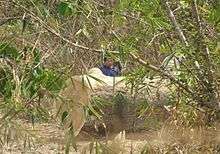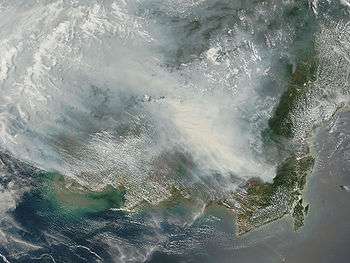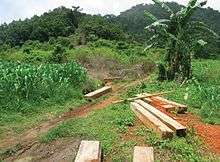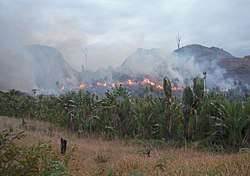Illegal logging
Illegal logging is the harvest, transportation, purchase or sale of timber in violation of laws. The harvesting procedure itself may be illegal, including using corrupt means to gain access to forests; extraction without permission, or from a protected area; the cutting down of protected species; or the extraction of timber in excess of agreed limits.
| Part of a series on |
| Environmental law |
|---|
 |
| Pollution control law |
| Natural resources law |
| Reference materials |
| Related topics |
Illegality may also occur during transport, such as illegal processing and export; fraudulent declaration to customs; the avoidance of taxes and other charges, and fraudulent certification.[1]
Overview
| Logging in national parks: the case of Korindo (Indonesia) |
| In March 2004, Greenpeace carried out actions against a cargo ship transporting timber from the Indonesian company Korindo, which was being imported into France, UK, Belgium and the Netherlands.
Korindo is known to be using illegal timber from the last rainforests of Indonesia. In May 2003, an Indonesian Government investigation confirmed that Korindo was receiving illegal timber from notorious timber barons known to obtain timber from an orang-utan refuge – the Tanjung Puting National Park.[2][3] Tanjung Puting National Park is a 4,000 square kilometre conservation area of global importance. It is recognised as a world biosphere reserve by the United Nations and forms the largest protected area of swamp forest in South-East Asia. |
Illegal logging is a pervasive problem, causing enormous damage to forests, local communities, and the economies of producer countries. The EU, as a major timber importer, has implemented the European Union Timber Regulation as means to halt the import of illegally sourced wood products. The identification of illegally logged or traded timber is technically difficult. Therefore, a legal basis for normative acts against timber imports or other products manufactured out of illegal wood is missing. Scientific methods to pinpoint the geographic origin of timber are currently under development[4][5][6][7][8]. Possible actions to restrict imports cannot meet with WTO regulations of non-discrimination. They must instead be arranged in bilateral agreements. TRAFFIC,[9] the wildlife trade monitoring network, strives to monitor the illegal trade of timber and provide expertise in policy and legal reviews.[10]
Scale
It is estimated that illegal logging on public land alone causes losses in assets and revenue in excess of US$10 billion annually.[11] Although exact figures are difficult to calculate, given the illegal nature of the activity, decent estimates show that more than half of the logging that takes place globally is illegal, especially in open and vulnerable areas such as the Amazon Basin,[12] Central Africa, Southeast Asia, the Russian Federation.[13]
Available figures and estimates must be treated with caution. Governments tend to underestimate the situation, given that high estimates of illegal logging may cause embarrassment as these suggest ineffective enforcement of legislation or, even worse, bribery and corruption. On the other hand, environmental NGOs publish alarming figures to raise awareness and to emphasise the need for stricter conservation measures. For companies in the forestry sector, publications making high estimates can be regarded as potentially threatening for their reputation and their market perspective, including the competitiveness of wood in comparison to other materials. However, for many countries, NGOs are the only source of information apart from state institutions, which probably clearly underestimate the true figures. For example, the Republic of Estonia calculated a rate of 1% illegally harvested timber in 2003, whereas it was estimated to reach as much as 50% by the NGO "Estonian Green Movement".[14] In Latvia, the situation is comparable; anecdotal evidence points towards 25%[15] of logging being illegal.
Consequences

Illegal logging contributes to deforestation and by extension global warming, causes loss of biodiversity, and undermines the rule of law. These illegal activities undermine responsible forest management, encourage corruption and tax evasion and reduce the income of the producer countries, further limiting the resources producer countries can invest in sustainable development. Illegal logging has serious economic and social implications for the poor and disadvantaged with millions of dollars worth of timber revenue being lost each year.[16]
Furthermore, the illegal trade of forest resources undermines international security, and is frequently associated with corruption, money laundering, organized crime, human rights abuses and, in some cases, violent conflict. In the forestry sector, cheap imports of illegal timber and forest products, together with the non-compliance of some economic players with basic social and environmental standards, destabilise international markets. This unfair competition affects those European companies, especially the small and medium-sized companies that are behaving responsibly and ready to play by fair rules.
timber harvesting
Illegal logging in Southeast Asia
Indonesia

An estimated 73 percent of all logging in Indonesia is believed to be illegal.[17] Most of the methods adopted for deforestation in Indonesia are illegal for a multitude of reasons.
Private corporations, motivated by economic profits from local and regional market demands for timber, are culpable for deforestation. These agro-industrial companies often do not comply with the basic legal regulations by inappropriately employing cost effective yet environmentally inefficient deforestation methods such as forest fires to clear the land for agricultural purposes. The 1999 Forestry Law states that it is essential for companies to be endorsed by authorities in respective regions with an IPK permit, a timber harvesting permit, for legal approval of their deforestation activities.[18] Many of these corporations could circumvent this red tape, maximise revenue profits by employing illegal logging activities as lax law enforcement and porous law regulations in large developing countries like Indonesia undermine forestry conservation efforts.[19]
In the social landscape, small-scale subsistence farmers in rural areas, who received minimal education, employ a basic method of slash-and-burn to support their agricultural activities. This rudimentary agricultural technique involves the felling of forest trees before a dry season and, subsequently, the burning of these trees in the following dry season to provide fertilisers to support their crop activities. This agricultural practice is repetitively employed on the same plot of land until it is denuded of its nutrients and could no longer suffice to support agricultural yields. Thereafter, these farmers will move on to occupy another plot of land and continually practice their slash-and-burn technique.[20] This contributing social factor to deforestation reinforces the challenges faced by forestry sustainability in developing countries such as Indonesia.
On the political front, the Indonesian governmental role in curbing deforestation has largely been criticised. Corruption amongst local Indonesian officials fuels cynicism with regard to the governmental clampdown on illegal logging activities. In 2008, the acquittal of a proprietor for a timber firm, Adelin Lis, alleged for illegal logging further galvanised public opinion and drew criticisms at the Indonesian political institution.[21]
The Indonesian government grapples with the management of deforestation with sustainable urban development as rural-urban migration necessitates the expansion of cities.[22] The lack of accountability to deforestation with pertinence to transmigration projects undertaken by the Indonesian government illustrates minimal supporting evidence to testify to considerations for forestry sustainability in their development projects. This further augments scepticism in the Indonesian government's credibility in efficiently and responsibly managing their urban development projects and forestry conservation efforts.[23]
Myanmar
Due to the size and scope of Burma’s forests, it is difficult for government organisations like Forest Department to regulate logging. There is a high demand for timber from Burma’s neighbours–notably Thailand and China–who have depleted their forests much more than Burma (plunder).[24] As a result, numerous illegal logging operations have sprung up near the Thai-Burmese border and in the province of Kachin along the Chinese border. Logs are commonly cut on the Burmese side and then smuggled to processing facilities in China or Thailand.[24]
Lack of regulations has led to unbridled and destructive logging that has caused environmental damage such as soil erosion, river contamination, and increased flooding.[25] In Kachin State, which has some of the largest expanses of relatively untouched forest, illegal logging accounts for up to half of the deforestation.[25] Due to the remoteness of these regions and the international demand for hardwoods, illegal logging is a threat that is hard to address and will probably continue contributing to deforestation. A major problem is that illegal logging is still classified in Myanmar as an environmental matter, and not as a criminal act, making it difficult for the Forest Department to bring a lawsuit against the offenders.[26]
Cambodia
Illegal logging poses a large threat to Cambodia's forests. It allows for undocumented and unauthorized deforestation in which allows for the exploitation of Cambodia's forests. There are many cases in which the military carries out illegal logging without knowledge from the government. It is difficult for central government officials to visit areas still controlled by former Pol Pot forces.[27] Illegal commercial timber interests take advantage of weak law enforcement to benefit from illegal cutting. The majority of illegal deforestation is done by the military and powerful sub-contractors.[28]
Thailand
Governmental officials in charge of protected areas have contributed to deforestation by allowing illegal logging and illegal timber trading. King Bhumibol Adulyadej has blamed the destruction of Thailand's forested areas on the greed of some state officials. This is evident in places such as large protected swathes of northern Nan Province that were formerly covered with virgin forest and that have been deforested even while having national park status.[29] Given that a mature, 30 year-old Siamese rosewood tree can fetch 300,000 baht on the black market, illegal logging is unlikely to disappear.[30][31]
Statistics
| Box 2. Loss of revenue to governments of producer countries |
| The scale of illegal logging represents a major loss of revenue to many countries and can lead to widespread associated environmental damage. A senate committee in the Philippines estimated that the country lost as much as US$1.8bn per year during the 1980s.[32] The Indonesian government estimated in 2002 that costs related to illegal logging are US$3bn each year.[33] The World Bank[34] estimates that illegal logging costs timber-producing countries between 10 and 15 billion euros per year. This compares with 10 billion euros disbursed as EC aid in 2002.[35] |
- A joint UK-Indonesian study of the timber industry in Indonesia in 1998 suggested that about 40% of throughput was illegal, with a value in excess of $365 million.[36] More recent estimates, comparing legal harvesting against known domestic consumption plus exports, suggest that 88% of logging in the country is illegal in some way.[3] Malaysia is the key transit country for illegal wood products from Indonesia.[37]
- In Brazil, 80% of logging in the Amazon violates government controls.[38] At the core of illegal logging is widespread corruption. Often referred to as 'green gold', mahogany can fetch over US$1,600 m-3. Illegal mahogany facilitates the illegal logging of other species, and widespread exploitation of the Brazilian Amazon. Recent Greenpeace investigations in the Brazilian state of Pará reveal just how deeply rooted the problem remains. No reliable legal chain of custody exists for mahogany, and the key players in its trade are ruthless.[39]
- The World Bank estimates that 80% of logging operations are illegal in Bolivia and 42% in Colombia,[40] 10 while in Peru, illegal logging constitutes 80% of all activities.[41]
- Research carried out by WWF International[42] in 2002 shows that in Africa, rates of illegal logging vary from 50% for Cameroon and Equatorial Guinea to 70% in Gabon and 80% in Liberia – where revenues from the timber industry also fuelled the civil war.
- WWF estimates that illegal logging in Russia is at least 20%, reaching up to 50% in its far eastern regions.[43]
- A 2012 joint study by the United Nations Environment Programme and Interpol states that illegal logging accounts for up to 30% of the global logging trade and contributes to more than 50% of tropical deforestation in Central Africa, the Amazon Basin and South East Asia.[44]
Political processes
.jpg)
East Asia

The East Asia Forest Law Enforcement and Governance (EA FLEG) Ministerial Conference took place in Bali in September 2001. The Conference brought together nearly 150 participants from 20 countries, representing government, international organizations, NGOs, and the private sector. The event was co-hosted by the World Bank and the Government of Indonesia. The meeting included detailed technical discussions of forest law enforcement in relation to governance, forest policy and forest management as well as ministerial engagement.
The Conference's primary aims were to share analysis on forest law enforcement; explore priority issues of forest law enforcement, including illegal logging in the East Asia region, among senior officials from forest and related ministries, NGOs and industry representatives; and commit to action at the national and regional level.
European Union
In May 2003, the European Commission presented the EU Forest Law Enforcement, Governance and Trade Action Plan (EU FLEGT). This marked the beginning of a long process by which the EU aims to develop and implement measures to address illegal logging and related trade. The primary means of implementing the Plan is through Voluntary Partnership Agreements with timber producing countries. The European Union Timber Regulation was adopted in 2010 and went into effect 3 March 2013.[47]
- It prohibits the placing on the EU market for the first time of illegally harvested timber and products derived from such timber;[47]
- It requires EU traders who place timber products on the EU market for the first time to exercise 'due diligence';[47]
- Once on the market, the timber and timber products may be sold on and/or transformed before they reach the final consumer.[47]
- To facilitate the traceability of timber products, economic operators in this part of the supply chain (referred to as traders in the regulation) have an obligation to keep records of their suppliers and customers.[47]
A Greenpeace investigation published in May 2014 demonstrates that EU Timber Regulation is ineffective if fraudulent paperwork is accepted at face value and there is not sufficient enforcement by EU authorities.[12]
Africa
The Africa Forest Law Enforcement and Governance (AFLEG) Ministerial Conference was held in Yaoundé, Cameroon in October 2003. The meeting drew together ministers and stakeholders from Africa, Europe and North America to consider how partnerships between producers, consumers, donors, civil society and the private sector could address illegal forest exploitation and associated trade in Africa.
The AFLEG conference, the second regional forest law enforcement and governance meeting after East Asia, resulted in endorsement of a ministerial declaration and action plan as well as a variety of informal implementation initiatives.
In 2014, the FAU-EU-FLEGT Programme[48] of the Food and Agriculture Organization of the United Nations published the study The Voluntary Partnership Agreement (VPA) process in Central and West Africa: from theory to practice[49] to document and foster strategic reflection in partner countries already engaged in negotiating a VPA - or those who will be entering into such negotiations - by providing examples of good practices. These good practices were identified and recorded following interviews with the main stakeholders in the eight VPA countries in West and Central Africa, the European Forest Institute's (EFI) EU FLEGT Facility[50] and the European Commission. In 2016, the FAO-EU FLEGT Programme published an additional study, Traceability: a management tool for business and governments, providing examples of good practices in the region's traceability systems, which help prevent illegal logging by tracking timber from its forest of origin throughout its journey along the supply chain.
Saint Petersburg Declaration
The Europe and North Asia Forest Law Enforcement and Governance (ENA FLEG) Ministerial Conference was held in Saint Petersburg, Russia on 22–25 November 2005. In May 2004, the Russian Federation announced its intention to host the ENA FLEG process, supported by the World Bank. A preparatory conference was held in Moscow in June 2005.
The Saint Petersburg conference brought together nearly 300 participants representing 43 governments, the private sector, civil society and international organisations. It agreed to the Saint Petersburg Declaration on Forest Law Enforcement and Governance in Europe and North Asia. The Declaration includes an indicative list of actions, intended to serve as a general framework for possible actions to be undertaken by governments as well as civil society.
The conference took place as the United Kingdom prepared to pass the G8 Presidency to Russia. As Valery Roshchupkin, Head of the Federal Forestry Agency of the Russian Federation, confirmed, illegal logging would be of special importance for Russia as the G8 President and for the following G8 Summit, also held in Saint Petersburg.
United States
In response to growing concerns over illegal logging and advice from TRAFFIC[9] and other organisations,[10] on May 22, 2008 the U.S. amended the Lacey Act, when the Food, Conservation, and Energy Act of 2008 expanded its protection to a broader range of plants and plant products (Section 8204. Prevention of Illegal Logging Practices).[51]
The requirements under the new Amendments are two-fold. First, the Lacey Act now makes it illegal to import into the United States plants that have been harvested contrary to any applicable Federal Law, State Law, Indian Tribal Law, or Foreign Law. If a plant is found to have been harvested in violation of the laws of the country where it was harvested, that plant would be subject to seizure and forfeiture if imported into the U.S. The Lacey Act also makes it unlawful, beginning December 15, 2008, to import certain plants and plant products without a Plant and Plant Product import declaration.[52]
This Plant and Plant Product Declaration must contain (besides other information) the Genus, Species, and Country of Harvest of every plant found in commercial shipments of certain products, a list of applicable products (along with other requirements and guidance) can be found on the USDA APHIS website.[52]
Australia
The Timber Development Association (TDA) welcomes on June 6, 2014's release by the Australian Department of Agriculture of a position paper on the Illegal Logging Prohibition Regulation and guidance on how timber and wood products industry can comply on the Australian Government - Department of Agriculture[53] official website. The release of the Government's guidance coincides with the release of industry developed timber due diligence tools and information through the industry website of Timber Due Diligence.[54]
The Australian Illegal Logging Prohibition Regulation applies to importers into Australia of "regulated timber products" such as sawn timber, wood panels, pulp, paper products, and wood furniture. The Regulation starts on 30 November 2014 and requires that before import of these products or processing of raw logs, due diligence is undertaken to minimise the risk that the timber products or raw logs were illegally logged or incorporate illegally logged timber.[55]
See also
- Deforestation and climate change
- Environmental crime
- Environmental impact of roads
- Environmental Investigation Agency
- Environmental vandalism
- Illegal logging in Madagascar
- List of environmental issues
- Reducing emissions from deforestation and forest degradation (REDD)
- Timber mafia
- United Nations Forum on Forests
- UAV monitoring[56]
- Satellite surveillance[57]
- Preventing easy forest access (i.e. roads and waterways)[58]
References
- Jonathan Watts (24 August 2015). "Dawn timber-laundering raids cast doubt on 'sustainable' Brazilian wood". The Guardian. Retrieved 24 August 2015.
Most of the laundering was reportedly done through the creation of fake or inflated creditos florestais, a document that defines how much timber a landowner is entitled to extract from his property.
- "Protecting the Environment with Intelligence – EIA International". EIA International.
- "Protect forests". saveordelete.com. Archived from the original on 2014-01-04. Retrieved 2020-01-21.
- Kagawa A, Leavitt SW (2010). "Stable carbon isotopes of tree rings as a tool to pinpoint the geographic origin of timber". Journal of Wood Science. 56 (3): 175–183. doi:10.1007/s10086-009-1085-6.
- "Germany's wood detectives". DW.com. 20 March 2017. Retrieved 9 March 2020.
- Irwin, Aisling (3 April 2019). "Tree sleuths are using DNA tests and machine vision to crack timber crimes". Nature. 568: 19–21. doi:10.1038/d41586-019-01035-7.
- Kenny, Richard (10 June 2019). "People Fixing the World: Is your wood from a legal source? This test can tell". BBC. Retrieved 9 March 2020.
- Marc, Jenny (27 November 2019). "Scientists are building a vast library of tree DNA in the fight against deforestation". CNN. Retrieved 9 March 2020.
- "TRAFFIC - Wildlife Trade News". traffic.org.
- "TRAFFIC - Timber trade". traffic.org.
- "Havocscope Illegal Logging Market Value". Retrieved April 14, 2010.
- "The Amazon's Silent Crisis: The EU Market and the EUTR" (PDF). amazoncrisis.org. Green Peace. May 2014. Retrieved 25 August 2015.
Nearly 80% of the area logged in Pará between August 2011 and July 2012 was harvested illegally.
- For further details on illegal logging, see: Duncan Brack and Gavin Hayman (2001) Intergovernmental Actions on Illegal Logging. Royal Institute of International Affairs; Duncan Brack, Gavin Hayman and Kevin Gray (2002) Controlling the International Trade in Illegally Logged Timber and Wood Products. Royal Institute of International Affairs.
- Estonian Green Movement (2004) Illegal forestry and Estonian timber exports
- WWF Latvia (2003)</rev> The features of illegal logging and related trade in Baltic Sea region; WWF International (2002) The Timber Footprint of the G8 and China
- "TRAFFIC - Wildlife Trade News - Tanzania's disappearing timber revenue". traffic.org.
- indonesia trees indonesia without trees? Record breaking logging of last rainforests Friends of the Earth
- "Indonesia's Sinar Mas Accused of Illegal Land Clearing". The Jakarta Globe. 10 December 2009. Archived from the original on 4 February 2013. Retrieved 18 August 2013.
- "88 percent of logging illegal: ICW". The Jakarta Post. 22 June 2011. Archived from the original on 25 May 2013. Retrieved 18 August 2013.
- Tony Waters, The Persistence of Subsistence Agriculture, p. 3. Lexington Books (2007)
- "INECE Newsletter – 16th Edition". Inece.org. Archived from the original on 7 January 2008. Retrieved 18 August 2013.
- William D. Sunderlin and Ida Aju Pradnja Resosudarmo: "Rates and Causes of Deforestation in Indonesia: Towards a Resolution of the Ambiguities", in CIFOR Occasional Paper no.9, 1996
- Transparency International: "Tackling Political Corruption to Combat Illegal Logging", Project paper, 2011
- Talbott, Kirk; Melissa Brown (1998). "Forest Plunder in Southeast Asia: An Environmental Security Nexus in Burma and Cambodia". Environmental Change and Security Project Report (4): 53–60.
- Brunner, Jake; Kirk Talbott; Chantal Elkin (August 1998). Logging Burma's Frontier Forests: Resources and the Regime. World Resources Institute.
- Ikunaga, Meguri. The Forest Issue in Cambodia : Current Situation and Problems : An Analysis Based on Field Research. Occasional Paper. Tokyo: Foundation for Advanced Studies on International Development, International Development Research Institute, 1999. Print.
- Hansen, Kasper K., and Neth Top. Natural Forest Benefits and Economic Analysis of Natural Forest Conversion in Cambodia. Working paper no. 33. Phnom Penh: Cambodia Development Resource Institute, 2006. Print.
- "King says greed a factor in floods". Bangkok Post. 2012-02-25. Retrieved 22 Apr 2015.
- Land, Graham (2016-01-08). "'More valuable than gold': Thailand's fight to save the Siamese Rosewood". Asian Correspondent. Retrieved 5 April 2016.
- Debra Callister (1992) Illegal tropical timber trade: Asia Pacific. TRAFFIC International
- ICG (2001) Natural Resources and Law Enforcement in Indonesia
- World Bank (2002) Revised Forest Strategy’’
- Annual report 2003 from the Commission to the Council and the European Parliament on the EC Development Policy and the implementation of External Assistance in 2002
- Indonesia-UK Tropical Forestry Management Programme (1999) Illegal Logging in Indonesia. ITFMP Report No. EC/99/03
- Environmental Investigation Agency and Telapak (2004) Profiting from Plunder: How Malaysia Smuggles Endangered Wood.
- WWF International (2002) The Timber Footprint of the G8 and China
- Greenpeace (2001) Partners in Mahogany Crime: Amazon at the mercy of gentlemen’s agreements.
- World Bank (2004) Forest Law Enforcement
- The Peruvian Environmental Law Society (2003) Case Study on the Development and Implementation of Guidelines for the Control of Illegal Logging with a view to Sustainable Forest Management in Peru.
- WWF International (2002) The Timber Footprint of the G8 and China.
- WWF press release, 30 March 2004.
- Illegal Logging Trade Decimates Forests, Africa: AllAfrica.com, 2012, retrieved 18 October 2012
- Central Africa: Organized Crime Trade Worth Over U.S. $30 Billion, Responsible for Up to 90 Percent of Tropical Deforestation, Africa: AllAfrica.com, 2012, retrieved 18 October 2012
- "Timber - Species we work with at TRAFFIC". www.traffic.org. Retrieved 2019-01-10.
- "Timber Regulation". ec.europa.eu. European Commission. Retrieved August 25, 2015.
Regulation (EU) No 995/2010 of the European Parliament and of the Council of 20 October 2010
- Food and Agriculture Organization of the United Nations. "EU FAO FLEGT programme". fao.org.
- The Voluntary Partnership Agreement (VPA) process in Central and West Africa: from theory to practice (PDF). FAO. 2014.
- "Home - EU FLEGT Facility". efi.int.
- Khatchadourian, Rafi (October 6, 2008). "The Stolen Forests: Inside the covert war on illegal logging". The New Yorker. Retrieved July 7, 2010.
- "U.S. Department of Agriculture Lacey Act Guidance". USDA APHIS. October 26, 2011.
- "Department of Agriculture Illegal Logging". daff.gov.au. Archived from the original on 2014-08-05. Retrieved 2014-07-28.
- "Timber Due Diligence". timberduediligence.com.au.
- "Australia: Illegal Logging Prohibition Regulation position paper welcomed by the timber industry". TDA. Fordaq S.A. 6 June 2014.
- UAV Drones Becoming Valuable Tools in Fighting Illegal Deforestation in Global Conservation Projects
- Satellite Technology Aims to Combat Illegal Logging in Real Time
- Logging
Further reading
- Monbiot, George (1991). Amazon Watershed. Michael Joseph. ISBN 0349101620.
- EIA and Telapak Indonesia (September 2001). "Timber trafficking: Illegal Logging in Indonesia, South East Asia and International Consumption of Illegally Sourced Timber" (PDF). Environmental Information Agency.
- Ravenel, Ramsay M.; Ilmi M. E. Granoff; Carrie A. Magee (18 January 2005). Illegal logging in the tropics: strategies for cutting crime. Routledge. ISBN 978-1-56022-117-3.
- Sheikh, Pervaze A., ed. (9 June 2008). "Illegal Logging: Background and Issues" (PDF). Congressional Research Service. Archived from the original (PDF) on 28 June 2011.
- Tacconi, Luca (2007). Illegal logging: law enforcement, livelihoods and the timber trade. London: Earthscan. ISBN 1-84407-348-3.
External links
| Wikimedia Commons has media related to Illegal logging. |
- Illegal Logging and Related Timber Trade - Dimensions, Drivers, Impacts and Responses (IUFRO World Series Volume 35) - 2017 report containing results of fifth global scientific assessment undertaken by the International Union of Forest Research Organizations (IUFRO)-led Global Forest Expert Panels (GFEP) initiative
- Policy Brief based on the report
- FAO-EU Forest Law Enforcement, Governance and Trade (FLEGT) Programme from the Food and Agriculture Organization of the United Nations
- European Commission page on illegal logging, with links to FLEGT Regulation (adopted in 2005) and EU Timber Regulation (adopted in 2010)
- Forest Legality Alliance
- Environmental Investigation Agency page on investigations related to illegal logging
